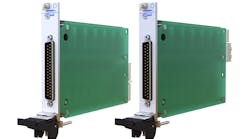Pickering Interfaces' 41-752A (PXI) and 43-752A (PXIe) battery simulator modules provide Electric Vehicle (EV) battery stack emulation in Battery Management Systems (BMS) test, enabling direct voltage and current readback programmatically or via a soft panel control. Occupying a single PXI slot, the battery simulator modules are highly accurate and specified at ±5 mV from 1 V to 7 V. Available with two, four, or six battery cell simulators per module, the simulators are fully isolated from ground and one other, enabling series connection to simulate batteries in a stacked architecture. The modules offer a 750 V isolation barrier to help simulate lower-power battery stacks, and battery charging emulation is available up to 100 mA.
Features include independent power and sense connections to sense a remote load and correct for wiring losses, the ability to respond to dynamic loads and independently read the voltage at the load as well as the output current for each cell. Using I/V readback the driver can automatically adjust the module's output voltage for higher accuracy.
According to Pickering's Simulation Product Manager, Paul Bovingdon, "with the increasing adoption of EVs as well as battery stacks for other applications, one of the significant challenges to be tackled is the effective testing and validation of the Battery Management Systems (BMS). Previously, test engineers have had to link simulation modules to a separate DMM to achieve voltage and current readback. Our new modules eliminate this requirement, making them simpler to use and more accurate. The 41-752A and 43-752A modules benefit from the modularity and scalability of the PXI/PXIe platform. These modules can be combined with Pickering's other PXI switch and simulation modules, including high voltage switching, fault insertion, thermocouple simulation, RTD simulation and more. They can also be combined with other vendors' PXI modules, such as a CANbus interface, to create a fully flexible BMS test system."
Software support allows users to design their applications with the operating system and programming languages (C/C++, .NET, Python, LabVIEW/LabWindows, MATLAB etc.) of their choice, and users can choose between Windows, Linux, or other hardware-in-the-loop (HIL) operating systems such as VeriStand, LabVIEW RT, and QNX.

